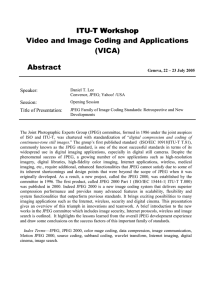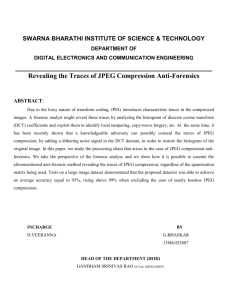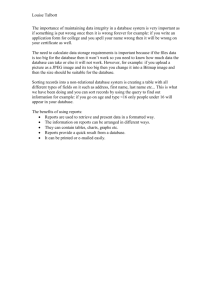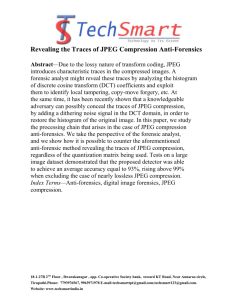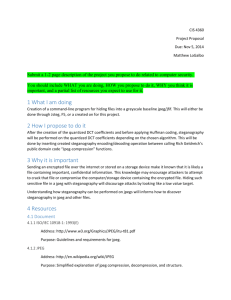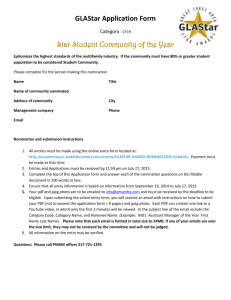JPEG digital imaging systems integration
advertisement
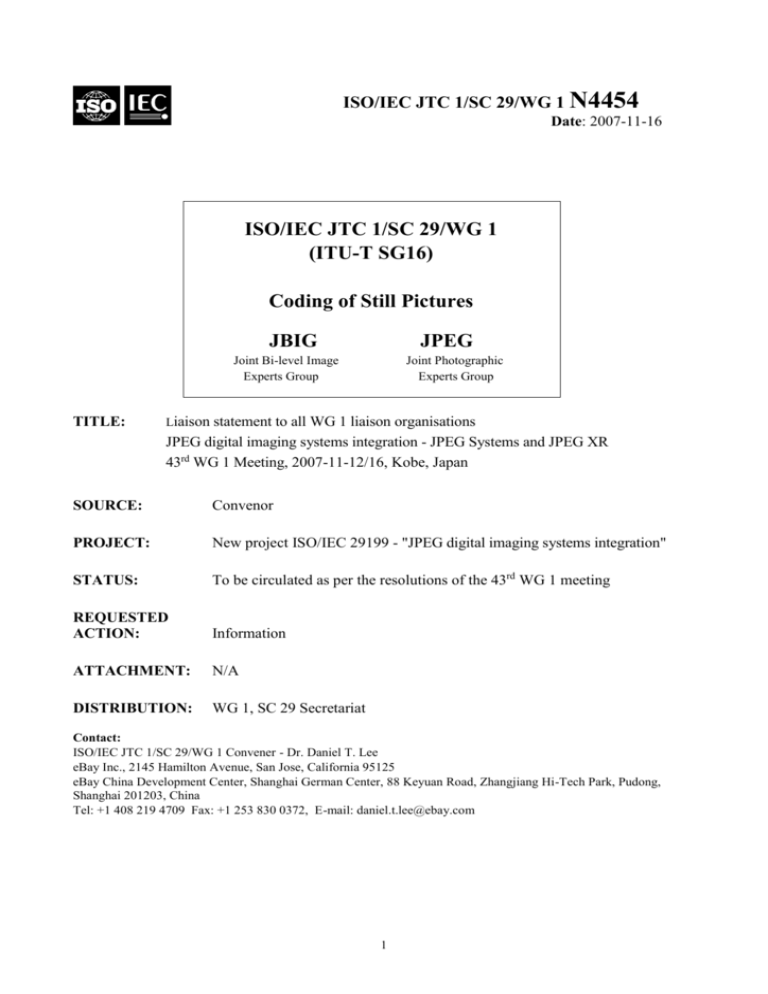
ISO/IEC JTC 1/SC 29/WG 1 N4454 Date: 2007-11-16 ISO/IEC JTC 1/SC 29/WG 1 (ITU-T SG16) Coding of Still Pictures JBIG JPEG Joint Bi-level Image Experts Group TITLE: Joint Photographic Experts Group Liaison statement to all WG 1 liaison organisations JPEG digital imaging systems integration - JPEG Systems and JPEG XR 43rd WG 1 Meeting, 2007-11-12/16, Kobe, Japan SOURCE: Convenor PROJECT: New project ISO/IEC 29199 - "JPEG digital imaging systems integration" STATUS: To be circulated as per the resolutions of the 43rd WG 1 meeting REQUESTED ACTION: Information ATTACHMENT: N/A DISTRIBUTION: WG 1, SC 29 Secretariat Contact: ISO/IEC JTC 1/SC 29/WG 1 Convener - Dr. Daniel T. Lee eBay Inc., 2145 Hamilton Avenue, San Jose, California 95125 eBay China Development Center, Shanghai German Center, 88 Keyuan Road, Zhangjiang Hi-Tech Park, Pudong, Shanghai 201203, China Tel: +1 408 219 4709 Fax: +1 253 830 0372, E-mail: daniel.t.lee@ebay.com 1 ISO/IEC JTC 1/SC 29/WG 1 (JPEG) wishes to report further progress to its liaison contacts on its new project ISO/IEC 29199 Information technology – Digital imaging systems integration. This project is intended to provide harmonization and integration between a wide range of existing and new image coding schemes, in order to enable the design and delivery of the widest range of imaging applications, across many platforms and technologies. It is intended within the “JPEG DI Systems” work to define profiles of existing Standards (both de jure and de facto), and, as relevant, complete new Standard parts, that can usefully be used in combination to deliver exciting and practical new applications of digital imaging technology. The work in JPEG Systems will recognize the industry needs to be able to match the real technical advances in sensor, network and display technology with the supporting image compression, associated metadata, and transmission technology. The first stages in this work are targeting the digital camera marketplace explicitly. At present we have work in progress toward the following Parts of this new suite of standards: – Part 1: Digital imaging systems (a technical report currently at “working draft” status) – Part 2: JPEG XR image coding specification (currently at “committee draft” status in the ISO/IEC approval process) – Part 3: JPEG XR image coding conformance testing (planned) – Part 4: JPEG XR image coding reference software (planned) Further Parts may developed for support of such capabilities as interactive imaging APIs and protocols, imagery access control and security, photorealistic 3-D immersive virtual environment imaging and “augmented reality”, workflow process coding for consumer photography applications, interaction between portable devices and display technologies, multi-projection technologies, etc. The current schedule plan for the ISO/IEC approval process of these Parts is as follows: ISO/IEC 29199-1 Title Digital imaging systems NP 07/07 WD 11/07 PDTR 03/08 DTR 07/08 TR 11/08 ISO/IEC 29199-2 Title JPEG XR image coding specification JPEG XR image coding conformance testing JPEG XR image coding reference software NP 07/07 WD 07/07 CD 11/07 FCD 03/08 FDIS 11/08 IS 03/09 11/07 03/08 11/08 03/09 07/09 11/07 03/08 11/08 03/09 07/09 29199-3 29199-4 The Part 1 digital imaging systems technical report will discuss use cases and technical issues and solutions which should be met by the ISO/IEC 29199 series of Standards. JPEG XR as specified in Part 2 is a coding format designed for use with all types of continuoustone photographic content, and is based on proposals submitted to JPEG by Microsoft, incorporating their “HD Photo” coding technology, as currently shipped within their Windows Vista operating system. The capabilities that it is designed to enable include the following: – High performance, embedded-system friendly compression, particularly characterized by – Small memory footprint – Integer-only operations with no divides – High compression quality – Lossless or lossy compression using the same algorithm 2 – – – Support for a wide range of represented sample formats, including: – Monochrome, RGB, CMYK or N-component image representation – 8 or 16 bit unsigned integer – 16 or 32 bit fixed point – 16 or 32 bit floating point – Several packed bit formats – 1 bit monochrome – 5 or 10 bit RGB – RGBE “Radiance” format Alpha plane support, and Bit-exact specification of decoded results for both fixed and floating point image formats. Based on the current state of patent declarations made to WG 1, it is intended that JPEG XR can be implemented on a royalty-fee-free and license-fee-free basis. Parts 3 and 4 are supporting standards relating to the JPEG XR coding technology specified in Part 2. We would warmly welcome your collaboration and support in this work, and welcome inputs and liaison activity within your areas of interest and expertise. WG 1 greatly values its ongoing partnership with its liaison partners and suggests that you be able to work with and assist WG 1 in standardization of these specifications and its ongoing work in this important area. Full access to JPEG’s web based electronic document register and historical document archive would be granted to any liaison representatives, and we would hope that this information flow could be reciprocated to allow an open and wide reaching exchange of relevant documents and information. A copy of the CD of Part 2 will be made available publicly through the JPEG web site in accordance with JPEG’s normal policy, and we would encourage its widest dissemination to any interested experts within your committee. 3
